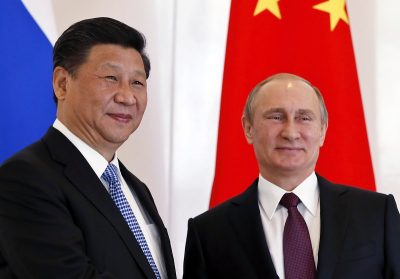Russia-China Joint Statement on NATO: What it Says and What it Doesn’t

Much has already been and even more will be said about the joint statement issued on February 4 by the presidents of Russia and China, Vladimir Putin and Xi Jinping, entitled Joint Statement of the Russian Federation and the People’s Republic of China on the International Relations Entering a New Era and the Global Sustainable Development.
In the version posted on the webpage of the Russian head of state it runs to several pages and encompasses a wide array of issues relating to security, arms control, the threat of military blocs (new and emerging), trade, climate change, COVID-19 and other regional and international concerns.
The nations jointly pledge support to multinational organizations, formats and initiatives like the United Nations, Asia-Pacific Economic Cooperation, BRICS (Brazil, Russia, India, China, South Africa), Shanghai Cooperation Organization, Eurasian Economic Union, Belt and Road Initiative and Association of Southeast Asian Nations.
The opening sentences run as follows:
“Today, the world is going through momentous changes, and humanity is entering a new era of rapid development and profound transformation.
It sees the development of such processes and phenomena as multipolarity, economic globalization, the advent of information society, cultural diversity, transformation of the global governance architecture and world order; there is increasing interrelation and interdependence between the States;
a trend has emerged towards redistribution of power in the world;
and the international community is showing a growing demand for the leadership aiming at peaceful and gradual development.”
But it’s not until the third of five sections that the issues of global competition and conflict are addressed.
Russia pledges to support the one-China policy vis-a-vis Taiwan, expresses concerns over Australia-United Kingdom-U.S. (AUKUS) military cooperation ( the two nations “call on AUKUS participants to fulfil their nuclear and missile non-proliferation commitments in good faith”) and joins with China in warning Japan about releasing contaminated water from the defunct Fukushima nuclear power plant.
Concern is voiced over Washington’s withdrawal from the Treaty on the Elimination of Intermediate-Range and Shorter-Range Missiles, its plans to develop and potentially to deploy intermediate-range and shorter-range ground-based missiles (to both Europe and Asia), its global missile defence (which it can employ “in various regions of the world”) and its involvement in the weaponization of outer space as well as its role in cyber, chemical, bacteriological (“domestic and foreign bioweapons activities by the United States and its allies”) and information technology warfare.
As will be noted, the issues raised, when not global in nature, appear to relate more to China’s than to Russia’s immediate security concerns.
In the paragraph which follows, which has and will continue to draw the most attention and generate the most commentary, NATO is mentioned for the only time.
There is no mention of Ukraine at all. (Last heard China still recognizes Crimea as part of Ukraine.) And even the paragraph that mentions NATO (again, the only time in the document) pairs it with a comparable concern about the Asia-Pacific region.
The criticism of NATO is a very constricted one, evidently all that Moscow could get Beijing to agree to, though it’s not much less than Russia’s own limited and tepid criticism.
“The sides believe that certain States, military and political alliances and coalitions seek to obtain, directly or indirectly, unilateral military advantages to the detriment of the security of others, including by employing unfair competition practices, intensify geopolitical rivalry, fuel antagonism and confrontation, and seriously undermine the international security order and global strategic stability.
The sides oppose further enlargement of NATO and call on the North Atlantic Alliance to abandon its ideologized cold war approaches, to respect the sovereignty, security and interests of other countries, the diversity of their civilizational, cultural and historical backgrounds, and to exercise a fair and objective attitude towards the peaceful development of other States.
The sides stand against the formation of closed bloc structures and opposing camps in the Asia-Pacific region and remain highly vigilant about the negative impact of the United States’ Indo-Pacific strategy on peace and stability in the region.”
There is no demand for NATO’s abolition; no criticism of its almost doubling the number of its members since 1999, all the fourteen new members in Eastern Europe;
no demand that the U.S. remove nuclear weapons based in five European countries under NATO nuclear sharing arrangements;
no concern about the military bloc openly proclaiming itself a nuclear alliance that reserves the right to launch first-strike nuclear attacks;
no complaint of it incorporating forty nations around the world in military partnerships, including nineteen in the Asia-Pacific area; no demand it remove battle groups, air patrols, cyber warfare, training and other centers, and Standard Missile-3 interceptors in nations bordering Russia.
The sole objections of China and Russia to NATO expressed in the joint declaration are to its further expansion – presumably adding Georgia and Ukraine – and its “ideologized cold war approaches.” Those two points are valid ones, but woefully deficient in terms of what is required.
An editorial by Vladimir Putin on the website of Xinhua the preceding day dealt with the real essence of the Sino-Russia partnership: trade, business, energy, currency transactions, vaccines and transportation.
It doesn’t hurt to hear the presidents of Russia and China jointly issue a word of criticism regarding NATO. But it’s only a word, or a sentence, and not the last that must be sounded.

